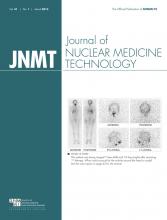
Brenda King, CNMT, FSNMMI-TS
Where are you on your career path? Are you just preparing to complete your training as an imaging professional? Perhaps you are midstream, having celebrated 10–15 years in the field? Maybe you are the seasoned professional, the one everyone goes to for insight and clarification on an existing protocol. Wherever you are along the continuum of your career, you must have had a plan. Maybe you had a mental picture or road map of where you wanted to be when you “grew up.” Did you have a dream of who you would be and what you would be doing as your life’s work? Without a plan, you will never know when you have arrived or met your goals.
Every 3–5 years, SNMMI and SNMMI-TS sharpen their pens and develop a new road map to plot the course of the Society toward a new destination and new goals—to boldly go where no professional society has gone before. The question we aim to answer is, “what will SNMMI and SNMMI-TS look like in 2020 and beyond?” The strategic planning process is currently under way, incorporating stakeholders from industry, research, optical imaging, advocacy, education, students, management, advanced practice, leadership, and staff. Working together, we can help chart the course for the future of our specialty.
One way that SNMMI and SNMMI-TS are making an impact on the field is through the Society’s participation in the American Board of Internal Medicine’s Choosing Wisely campaign. The Choosing Wisely campaign is designed to help physicians, patients, and other health-care stakeholders think and talk about the best use of health-care resources in the United States. By identifying specific tests or procedures that physician specialty societies say are commonly used but not always necessary in their respective fields, the societies aim to stimulate discussion about the need—or lack thereof—for many frequently ordered tests or treatments, many of which are requested by patients.
To create its list, SNMMI developed a working group consisting of the SNMMI leadership; presidents of the SNMMI brain imaging, cardiovascular, general clinical nuclear medicine, nuclear oncology, and pediatric councils; and several at-large members. The council presidents worked with their respective members to identify examples of nuclear medicine procedures that may not be used appropriately. After a list was created, the working group convened and determined the final 5 recommendations.
In February at a press conference in Washington, DC, SNMMI joined with 16 other medical specialty societies and released a list of 5 things physicians and patients should question. The list provides specific, evidence-based recommendations that physicians and patients should discuss to help make wise decisions about the most appropriate care based on their individual situation. Below is the list; support points and references can be found at www.snmmi.org/choosingwisely.
Don’t use PET/CT for cancer screening in healthy individuals.
Don’t perform routine annual stress testing after coronary artery revascularization.
Don’t use nuclear medicine thyroid scans to evaluate thyroid nodules in patients with normal thyroid gland function.
Avoid using a computed tomography angiogram to diagnose pulmonary embolism in young women with a normal chest radiograph; consider a radionuclide lung study (“V/Q study”) instead.
Don’t use PET imaging in the evaluation of patients with dementia unless the patient has been assessed by a specialist in this field.
This is an ideal opportunity for the nuclear medicine profession to improve patient care by establishing a new, positive channel of communication with health-care providers. This effort could have a direct impact on SNMMI members, on patients, and on the profession. The initiative is supported by influential consumer-oriented partners such as Consumer Reports, the American Association of Retired Persons (AARP), and Wikipedia.
As we continue planning for the future of nuclear medicine and molecular imaging, I invite all members to share their feedback about where the Society should be heading. Your input is valuable to us all.







